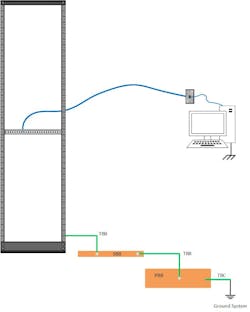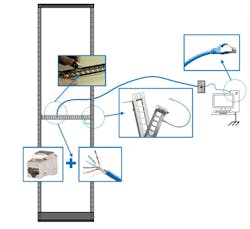Why effective shielding matters in your structured cabling system
By RON TELLAS, Belden -- There’s no doubt that a cabling system’s physical characteristics impact performance and reliability – but there’s another component of a high-performance cabling infrastructure to keep in mind: proper grounding, bonding and shielding.
In a recent Belden blog about grounding and bonding in telecommunications rooms, we covered the basics of grounding and bonding. Now we’re ready to talk about the other important component of a grounding and bonding system: an effective shielding system!
As a quick refresher, grounding (managed on the electrical side) creates an electrical connection to earth ground. This is usually done by driving a copper pole into the ground that can be connected to electrical utilities. To equalize equipment ground potential and reduce static discharge between devices, bonding then occurs to that grounding system.
Wherever cabling goes, grounding and bonding requirements follow
What Bonding Looks Like
In a bonded system, each cabinet or rack connects to a panel, which connects to cabling infrastructure.
Each of those racks or cabinets is also connected to a SBB (secondary bonding busbar), which connects to the PBB (primary bonding busbar) through a TBB (telecommunications bonding backbone). The PBB is connected to the building’s grounding system through the TBC (telecommunications bonding conductor) to provide the structured cabling system shielding.
Because it relies on the ground of the connected equipment, the setup presented above doesn’t require a shield for the jack at the work outlet.
Why is Effective Shielding Necessary?
Depending on the surrounding environment, a cable can pick up interference being released from nearby sources. Shielding reduces the effects of this kind of EMI (electromagnetic interference) in cabling systems, which are usually areas of very high EMI.
Effective shielding protects cables from signal interference and increases practical operating bandwidth levels. The success of your shielding system depends on several factors:
- Quality of cable installation and proper cable handling
- Quality and reliability of shield terminations (the foil connection needs to make good contact with the connector housing)
- Balance of the twisted pairs
- Impedance of the ground connection
- Ground potential difference between local and remote grounds
Verizon installer asks: Where is your rack grounding/bonding?
Myths About Effective Shielding
Effective shielding also prevents ground loops, which develop when there is more than one ground connection. If there’s a difference in common-mode voltage potential at these ground connections, noise is induced onto the cabling.
Many people think they can use an unshielded patch cord at the other end of the system’s shield, believing that this will break the flow of current from a large ground coupling and prevent a ground loop. But doesn’t correct the problem. If a common-mode voltage potential difference larger than 1v at each ground is present, then current will travel that path. Removing the shield at one end simply leaves it exposed to the next danger point. The problem still exists (and will likely come back to bite you later).
Belden recommends grounding at both ends of a shield. Otherwise, there may be a common-mode voltage potential difference and current may be flowing, leading to a ground loop. There should always be less than 1 Ohm resistance path to ground.
Effective Shielding: What the Standards Say
The standards that guide grounding, bonding and shielding include IEC 60364-1 and ANSI/TIA-607-C.
TIA standards dictate the following:
- The shield of shielded, twisted-pair cables shall be bonded to the SBB or PBB (generally through terminating the cable shield to the connector)
- The connector is bonded to the metallic panel frame, which is bonded per TIA guidelines
Voltage higher than 1 Vrms between the shielded cabling system at the equipment outlet and the ground wire of the corresponding electrical outlet expected to power the equipment isn’t grounded and, therefore, isn’t recommended.
Well-Balanced Cabling Systems
Belden’s solutions are always grounded at both ends to ensure a completely shielded system and avoid ground loops.
As shown below, our panels, which include a metal connector, are grounded to the rack or cabinet. The cable shield connects to the jack, which transmits to the work area outlet using a shielded patch cord.
A prediction for cabling standards in 2019
Regardless of whether a system is shielded or unshielded, however, the best solution is always a well-balanced system. Balanced cabling systems are much less susceptible to external noise, with minimal performance errors due to interference.
In a quality twisted-pair cable, impedance of the two wires in each pair is balanced relative to ground. Unwanted noise and crosstalk are coupled equally on to both pair conductors and do not interfere with the differential data signal. The more balanced a cable is, the better it can reject noise from external sources and limit the emittance of its own EMI signals.
RON TELLAS joined Belden in 2016 to help define the roadmap of technology and applications in the enterprise. Prior to this, he developed cables and connectivity for Panduit and Andrew Corp. Ron Tellas is a SME in RF design and Electromagnetic Propagation and has BSEE from Purdue University, a MSEE from IIT, and a MBA from Purdue University.>



